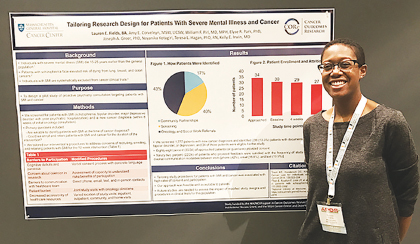
These findings underline the importance of vision function and ocular symptoms in quality of life after treatment for head and neck cancer.— Hsiao-Lan Wang, PhD, RN, and colleagues
Tweet this quote
Better vision function seems to be related to better quality of life after treatment for head and neck cancer, particularly among patients who have had surgery, according to Hsiao-Lan Wang, PhD, RN, Assistant Professor in the College of Nursing at the University of South Florida.
Head and neck cancer treatment involves the anatomic area of vision function and ocular structure, and according to Dr. Wang, as many as 43% of patients with head and neck cancer complain of vision changes after treatment.
She and her colleagues conducted the first study examining the relationships of vision function and ocular symptoms with quality of life among patients with head and neck cancer patients and presented their results in a poster at the 2017 American Psychosocial Oncology Society (APOS) Annual Conference in Orlando, Florida.1
Study Design
In this cross-sectional study, an Internet survey was distributed to 485 patients with head and neck cancer after their treatment. Three questionnaires were included in the survey: the National Eye Institute Visual Functioning Questionnaire, the Ocular Symptom Scale, and the Functional Assessment of Chronic Illness Therapy–Head and Neck (FACIT-H&N) questionnaire. Twenty-five percent of patients responded to the survey, for a total of 120 individuals evaluated.
The mean age of the study group was 64 years, with a mean of 47 months posttreatment. The majority of participants were male, white, and married, with college degrees and current alcohol use, and 53% of patients had a stage III or IV tumor. A total of 74% of patients had surgery, 64% underwent chemotherapy, 83% had radiation therapy, and 12% had corticosteroid treatment.
Vision Screening After Treatment
The researchers found that both vision function and ocular symptoms were significant predictors of physical well-being, but vision function was the only significant predictor of functional well-being, emotional well-being, social well-being, general quality of life, head and neck cancer quality of life, and total FACIT-H&N.

Research assistant Lauren Fields of the Massachusetts General Cancer Center, presents a poster at the 2017 American Psychosocial Oncology Society Annual Conference in Orlando, Florida. Photo courtesy of Massachusetts General.
The team also tested the interactions of treatment variables and found that surgically treated patients had better quality of life (functional well-being [P < .01], emotional well-being [P = .01], general quality of life [P = .04], and total FACIT-H&N [P = .02]) than nonsurgically treated patients at the same unit of vision function. However, nonsurgical patients had better functional and emotional well-being (P = .05) at the same unit of ocular symptoms, and patients who did not receive chemotherapy or corticosteroid treatment had better social well-being at the same unit of ocular symptoms (P = .03).
According to the investigators, these findings underline the importance of vision function and ocular symptoms in quality of life after treatment for head and neck cancer. Although better vision function is associated with better quality of life among patients who had surgery, patients with head and neck cancer who experience worse ocular symptoms after surgery, chemotherapy, and corticosteroids may experience poorer functional, emotional, and social well-being.
Based on this study, the researchers urge regular vision screening for patients after treatment of head and neck cancer. ■
Disclosure: Dr. Wang reported no potential conflicts of interest.
Reference

